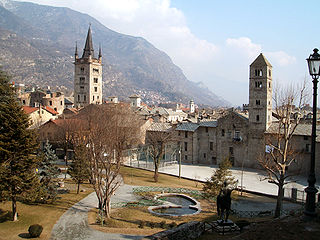
Lucca is a city and comune in Tuscany, Central Italy, on the Serchio River, in a fertile plain near the Ligurian Sea. The city has a population of about 89,000, while its province has a population of 383,957.

Assisi is a town and commune of Italy in the Province of Perugia in the Umbria region, on the western flank of Monte Subasio.

Susa is a town and comune in the Metropolitan City of Turin, Piedmont, Italy. In the middle of Susa Valley, it is situated on at the confluence of the Cenischia with the Dora Riparia, a tributary of the Po River, at the foot of the Cottian Alps, 51 km (32 mi) west of Turin.

Piazza dei Cavalieri is a landmark in Pisa, Italy, and the second main square of the city. This square was the political centre in medieval Pisa. After the middle of 16th century the square became the headquarters of the Order of the Knights of St. Stephen. Now it is a centre of education, being the main house of the Scuola Normale di Pisa, a higher learning institution part of the University.

The Basilica of San Frediano is a Romanesque church in Lucca, Italy, situated on the Piazza San Frediano.

Bagni di Lucca is a comune of Tuscany, Italy, in the Province of Lucca with a population of about 6,100. The comune has 27 named frazioni (wards).

The Arles Amphitheatre is a Roman amphitheatre in Arles, southern France. Two-tiered, it is probably the most prominent tourist attraction in the city which thrived in Ancient Rome. The towers jutting out from the top are medieval add-ons.

Poggio Mirteto is a comune (municipality) is situated in the Tiber Valley area of the region of Latium, Italy. Administratively Poggio Mirteto is in the province of Rieti and geographically this municipality is about 45 kilometres (28 mi) northeast of Rome and about 20 kilometres (12 mi) southwest of Rieti.

Luni is a comune (municipality) in the province of La Spezia, in the easternmost end of the Liguria region of northern Italy. It was founded by the Romans as Luna. It gives its name to Lunigiana, a region spanning eastern Liguria and northern Tuscany.

Piazza della Repubblica is a city square in Florence, Italy. It was originally the site of the city's forum; then of its old ghetto, which was swept away during the improvement works, or Risanamento, initiated during the brief period when Florence was the capital of a reunited Italy—work that also created the city's avenues and boulevards. At that time, the Loggia del Pesce from the Mercato Vecchio was also moved to Piazza Ciompi. The square's Giubbe Rosse cafe has long been a meeting place for famous artists and writers, notably those of Futurism.

San Francesco is a former Gothic-style Roman-Catholic church and monastery located in Piazza San Francesco in central Lucca, Tuscany, Italy. Since its restoration, it is home to IMT School for Advanced Studies Lucca, a superior graduate school.

The Roman Amphitheatre of Florence was a Roman amphitheatre in Florence, Central Italy. It was located between Piazza dei Peruzzi, Via De' Bentaccordi and Via Torta; its remains are visible in Via De' Bentaccordi.

San Ponziano is a Renaissance-style, former Roman Catholic church located on a piazza of the same name in Lucca, region of Tuscany, Italy. It is now the library of the IMT School for Advanced Studies Lucca.

San Benedetto in Gottella is a Romanesque-style, Roman Catholic church located on piazza Bernardin in Lucca, region of Tuscany, Italy. The church is located on Piazza Bernardini, near the Palazzo Bernardini, on the route of the ancient decumanus maximus of Lucca.

Santa Maria Forisportam, also called Santa Maria Bianca, is a Romanesque-style, Roman Catholic church located on piazza Santa Maria Bianca in Lucca, region of Tuscany, Italy.

Sant'Agostino is a Gothic-style, Roman Catholic church located in the piazza of the same name in central Lucca, Tuscany, Italy.

San Tommaso or San Tommaso in Pelleria is a Romanesque- style, Roman Catholic church located on Piazza of the same name in central Lucca, region of Tuscany, Italy.

San Cristoforo is a Romanesque and Gothic-style, former Roman Catholic church located on the narrow Via Fillungo in the center of Lucca, region of Tuscany, Italy. Now deconsecrated and stripped of its former interior altars and decoration, the chapel served as a memorial for those fallen in the wars..

The Amphitheatre of Capua was a Roman amphitheatre in the city of Capua, second only to the Colosseum in size and probably the model for it. It may have been the first amphitheatre to be built by the Romans. and was the location of the first and most famous gladiator school.

Santa Maria Assunta is a mixed Romanesque and Gothic-style, Roman Catholic parish church, with the facade on Piazza San Bernadino da Siena in the town center of Camaiore in the province of Lucca, Tuscany, Italy. The church is near the city hall of the town.





















